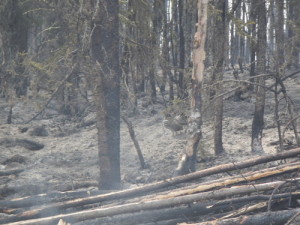
A Closeup Look At Alaska Wildfire

The Funny River fire has burned 156,000 acres of Kenai Peninsula land, prompting 600 firefighters into action to help slow down the blaze that, per the Anchorage Daily News, jumped the Kenai River over the holiday weekend. Our frequent contributors, Steve Meyer and Christine Cunningham, live in the area and have been assisting their friends coping with the dangers of a spreading wildfire. Steve was kind enough to send us an update:
The fire to this point has been as close to the “perfect storm” as one could hope for. For the past 15 years the central and northern sections of the Kenai Peninsula have been a tinderbox. That there would be a fire was of no question, it was only a matter of when. Originally the powers that be stated it was started from a campfire that was not properly doused but then stated perhaps not and, it was still under investigation. The Kenai does occasionally have lightening, which has started fires in years gone by but there were no lightening incidents at the time this one started so it is almost assuredly caused by human interaction. For this fire to go on for eight days without injury and at this point, no verified structure damage is nothing short of astonishing. The fire-fighting effort by Central Emergency Services, State Division of Forestry, the Canadian water bomber plains, National Guard helicopters and all of the volunteer assistance from local residents has been remarkable.
Social media has been the most up to date source of information for people and Brad Nelson, the communications fella with Central Emergency Services has done an amazing job of tireless reporting on their site keeping people informed. Numerous posts enlisting help of one sort or another have been posted and instantly there is more help available than needed. Even people from the Palmer/Wasilla area have volunteered their support. Local businesses have donated rooms for people evacuated from homes, pet care has been provided. The fire crews have had some shortages of personal things like socks and toothpaste and people are instantly providing these items. It has been a real heartwarming display of what can be done by people who care about their fellows.
At present, Monday evening (5 pm), the western flank (Kasilof area) seems to be secure. The northeastern flank is having some issues primarily due to a south wind that built up yesterday and blew cinders across the Kenai River. At the fire briefing this morning there were unconfirmed losses of several recreational cabins north of the Kenai River near the Killey River junction to the Kenai. On Monday the wind died down some, but it has picked back up again and this evening will likely produce expansion of the fire to the north.
People are concerned about wildlife loss in the fire. Most do not understand that even when moving rapidly a fire does not travel more than about ¾ mph. Wildlife easily remove themselves from the path, but of course there will be some loss of bird nests and any small animal young that are still in the nesting stages.
The eastern flank of the fire, which is towards the Kenai Mountains where there is no human habitation, has been largely ignored. It will burn out when it runs out of fuel on the mountain slopes.
The upside is the fire has not harmed anyone and frankly was long overdue. Wildlife in the area will benefit as they do in the aftermath of virtually all wildfires. New growth will sprout and the area will once again be the magnificent habitat it has been in years’ past. This fire could return the Kenai to the most prolific moose habitat in the world, as it once was.
The future is uncertain for the northern Kenai Peninsula. It too is a tinderbox waiting for a spark; depending on wind conditions when it happens, it could also spark a blaze, and the odds say it will be catastrophic. The current fire may promote some aggressive fire management from the Kenai National Wildlife Refuge, but that seems unlikely. They take a “natural diversity” stance and have been remiss in doing any real fire control work in the area. Rain is predicted for Tuesday afternoon and possibly Wednesday, but the peninsula is so dry at this point, it will take much more than a shower to have a significant effect on the current fire or the potential for future fire incidents. Alaska is unique in its ability to dry itself practically immediately after a good rain.
Here is the web address for CES, probably the most up-to-date and accurate information available on the fire: https://www.facebook.com/home.php#!/groups/219062911462753/
——————-
Much thanks to Steve and Christine, and here’s hoping everyone stays safe.



